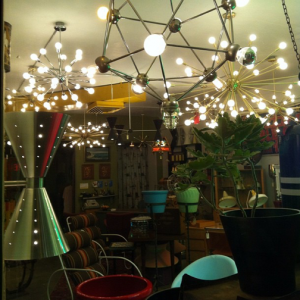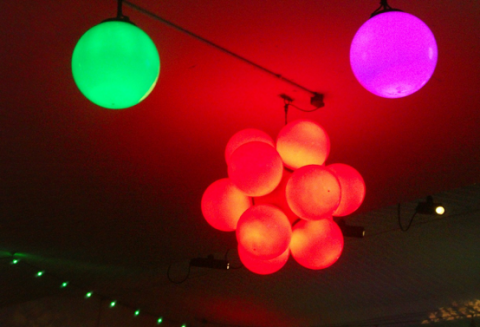The development of nuclear weapons had a notable impact on many aspects of American culture, including design. Spanning the late 1940s through about 1960, Atomic Age design is characterized by references and responses to nuclear science and the atomic bomb.
In the aftermath of World War II, the United States underwent a period of mass suburbanization. The new suburban homes constructed in this period were often modern, “simpler [and] more streamlined” than their predecessors (1). Many of these homes featured interior decorative elements inspired by the Atomic Age.
Some of these pieces drew inspiration from the structure of the atom itself, and incorporated visual representations of the atom as a motif. George Nelson’s 1949 Ball Wall Clock is a famous example of this. Other examples include this wallpaper or the lighting fixtures to the left and below.

Some speculate that the lighthearted visual appropriation of the atom in domestic objects was a way of taming anxieties over the destructive power of atomic weapons. Others believe that this trend reflected the optimism some Americans held toward the peacetime applications of atomic science, particularly its potential role in replacing coal and fuel as a source of electricity. Perhaps it was both, as Americans tried to contend with the complex implications of this new technology. Regardless of the precise motivation, the emergence of nuclear iconography in the home shows that the atom—with all its potential applications—was on the minds of everyday Americans.
Organic forms were another hallmark characteristic of Atomic Age design. This style used “shapes inspired by nature…to evoke living entities, ranging from amoebas and plant life to the human figure” (2). Organic design often employs “materials found in nature [for its] prevalently curvilinear” shapes (3).
This contrasted the previous dominant design aesthetic, in which “machines were revered as technical marvels and artistic icons, [and] cars, airplanes, and locomotives were celebrated in ordinary objects such as radios, clocks, and pencil sharpeners” (4).
One example of organic forms in design would be this 1946 chair, one of many designed by Charles and Ray Eames in the postwar period. Using molded plywood for “seat and back forms to fit the human anatomy” (3), this Eames chair—which was mass-produced by Herman Miller in the 1950s—eschews rigid geometry and industrial materials in favor of a more natural aesthetic.
The 1950s barkcloth tablecloth below also exemplifies organic forms in Atomic Age design, particularly in its stylized depiction of tree branches.

Art historians and museum curators do not think it is a coincidence that organic forms grew popular in design at the dawn of the Atomic Age. Some saw the trend as a “search for meaning at a time when conventional values were being called into question, when the technology that would win a war held the threat of mass annihilation” (4).
The curator of “Vital Forms: American Art and Design in the Atomic Age,” a 2001-2002 exhibit at the Brooklyn Museum, wrote in the exhibition catalog that “forms from the natural world were a comforting and humanizing antidote to the sharper forms of an older technology that had promised so much but delivered destruction” (4).The webpage for the exhibit refers to the use of organic forms in design as “a way of reasserting humane values” in the aftermath of worldwide crisis (5).
The Atomic Age also influenced fashion, its most enduring legacy being the bikini bathing suit. In 1946, French designer Jacques Heim debuted the Atome, which was branded as the “world’s smallest bathing suit.” Competing designer Louis Réard also capitalized on Atomic Age excitement when he debuted the bikini—named for the Bikini Atoll, the location for Operation Crossroads. The bikini was the first female bathing suit to expose the bellybutton, and Réard claimed it “was sure to be as explosive as the U.S. military tests.”
Atomic Age design principles influenced architecture, visual art, and other design styles. In particular, Googie architecture and Space Age design show significant Atomic Age influence. Though Atomic Age design was a relatively short-lived trend, its legacy lives on in contemporary retro designs, which offer a nostalgic return to this period.





